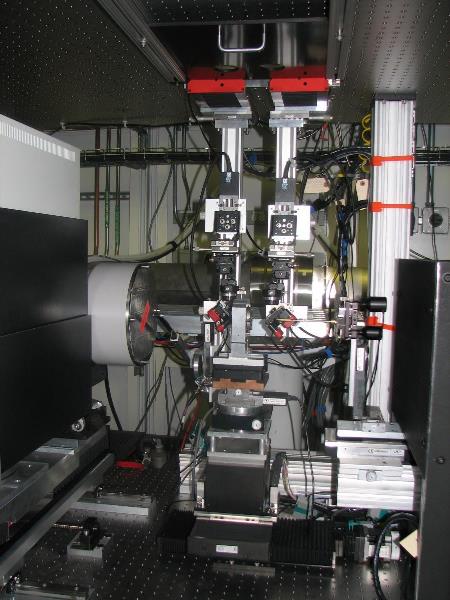ID-B Laser Heating Table
The laser heating system at 16-ID-B at the Advanced Photon Source (APS) features a state-of-the-art double-sided infrared laser heating setup integrated with monochromatic micro X-ray diffraction for investigating the structural properties of polycrystalline, single crystal, and amorphous materials under simultaneous ultra-high pressure and temperature (PT) conditions.
This system offers:
- Tunable Laser Heating Spot Sizes: Spot sizes ranging from 4 to over 60 microns in the flat-top area of the laser intensity profile (FWHM from 9 to over 120 microns). The system uses two identical IPG YLR-100-1064-WC fiber lasers capable of operating in continuous-wave or modulation mode.
- Precise Temperature Measurements: Simultaneous spectroradiometric temperature measurements from a 4-micron area in the center of the heating spot on both sides of the sample. The system is equipped with an Acton SpectroPro SP2560 imaging spectrograph and two advanced detectors: a back-illuminated CCD (PIXIS 400BR, Princeton Instruments) and an em-ICCD (PI-MAX4, Princeton Instruments). A mirror-pinhole setup at the spectrograph entrance allows precise alignment of the temperature sampling area with the center of the heating spot and the X-ray beam.
- Optimized X-ray Beam Quality: The incident X-ray beam can be focused to 2 × 2 microns (FWHM) using a 320 × 320 mm Kirkpatrick-Baez (KB) mirror or to 1 × 1 microns with a 200 × 100 mm KB mirror for enhanced resolution. A clean-up pinhole filters out tailing radiation intensity for optimal beam quality.
- X-ray Diffraction Detection: The system is equipped with a cutting-edge Pilatus 2M CdTe detector, enabling high-resolution data collection and enhanced sensitivity to X-rays, particularly in the hard X-ray range. This detector provides exceptional performance for polycrystalline, single crystal, and amorphous material studies under extreme conditions.
- Supporting Tools: The system includes online ruby fluorescence and Raman spectroscopy systems for pressure measurements and membrane-based remote pressure control for enhanced experimental flexibility. The laser heating table is also capable of remote operation if required.
Recent Enhancements:
• X-ray beam focusing to 1 × 1 microns using a 200 × 100 mm KB mirror.
• Advanced 2D XRD imaging for improved structural visualization.
• Time-resolved measurements using the em-ICCD detector for dynamic studies under extreme conditions.
The 16-ID-B laser heating system at APS offers high precision and flexibility for high-PT studies, making it an essential resource for cutting-edge materials science and geophysics research.
References:
1. Meng, Y., Hrubiak, R., Rod, E., Boehler, R., Shen, G. New developments in laser-heated diamond anvil cell with in-situ synchrotron X-ray diffraction at High Pressure Collaborative Access Team. Review of Scientific Instruments, 86, 072201 (2015). https://doi.org/10.1063/1.4926895.
2. Hrubiak, R., Smith, J. S., Shen, G. Multimode Scanning X-Ray Diffraction Microscopy for Diamond Anvil Cell Experiments. Review of Scientific Instruments, 90 (2), 025109 (2019). https://doi.org/10.1063/1.5057518.

